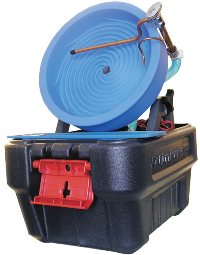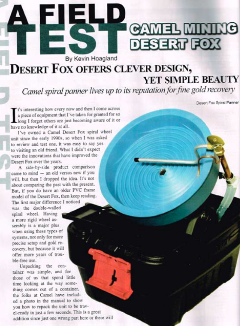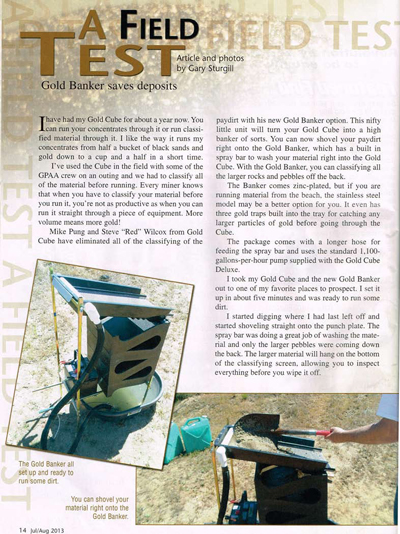Saturday, November 19 2022
If you’re used to water mining, having success in the desert might seem challenging— that is until you start thinking of desert ground During a river high-water event in a non-arid area, gold is moved over a larger area by massive water flows that continue until the water slows as the source dissipates its energy. Spring snow runoff is a good example. Rivers rise and sometimes flood based on the upstream water source. When the snow has melted, the river will slowly get back to normal. In the desert, gold is moved in the exact same way with the exception that water powerful enough to move gold does so and then just simply stops. In a flash flood, gold is moved very violently and often a very short distance, sometimes percolating into valuable pockets. Here’s where the difference between water and desert mining principles comes into play generally flood gold will concentrate in areas that do not meet the standard thought of inside bends and where the water flow becomes lower. For the most part, desert mining experts recommend staying out of the washes, gulches and dry river beds— that is unless you clearly see exposed bedrock. Gold will settle fairly quickly when it is trapped behind jagged bedrock and small fault lifts that have not been worn down over time by constant water flow. It IS true you can find areas of concentrated gold-bearing material in the washes, however, the amount of time and energy to get through feet of overburden is usually just not worth it, especially when there are higher values to be found outside of the wash. Follow the leads out of the wash to where the gold lives in higher concentration. Test and sample areas you see with a great deal of runoff from a tributary coming into the main wash. Here you are only digging through the current flood layer and testing for flood gold. Make your way out of the wash carefully looking at the bottom of the tributary and the areas where the water flowed into the tributary. Look closely for jagged bedrock and slight lifts in the ground and then prospect. Continue to test each of those spots. What started as a few specks of flood gold in the main wash can lead to larger and larger deposits on the flats or in slight inclines across the desert floor. Keep in mind that when a flash flood is dissipating, there is not enough energy to move a lot of rock, but the sand will continue to flow a bit, creating great clues. In general, cool season precipitation (October through April) is the most extensive source of rain in the desert regions. Rainfall is more widespread and of relatively long duration during the cool season. On the other hand, warm season precipitation (May through September) results largely from short monsoon-type thunderstorms. If you’re ready to head to a sunnier climate this winter, keep these tips in mind and you just might find enough similarities between water and desert mining to make you return every year. Good luck! Monday, January 19 2015
PI (pulse induction) detectors work a bit differently than the more common VLF (very low frequency) detectors by putting magnetic field energy into the ground and then switching off and waiting a short period before they start to look for a response. This makes them better at handling ground mineralization than a VLF detector because during that short delay the magnetic response of iron trash minerals that you don't want to find dies out. VLF detectors do not as easily cancel out ground mineralization the way a PI metal detector can do. Kevin Hoagland, Executive Director of Development for the Gold Prospectors Association of America recently field tested the Garrett ATX Deepseeker. Below is an excerpt of Kevin's review: "My first impression of the ATX was that it's compact, heavy and built like a tank, and all connections are waterproof. Battery installation is simple. The ATX uses 8 AA batteries in two 4-battery drop-in packs and comes with an 8-slot AA battery charger. Not only does this detector come with a rugged case and carry bag, but also everything else you need to get out detecting. The units ships with the 20 inch mono coil already installed. It is also shipped with headphones that are screwed into the back of the unit. I slipped my arm into the adjustable cuff, and grabbed the control pod. There was no unnecessary torque on
As with most large PI detectors, the Garrett ATX Deepseeker Metal Detector is not light, and the waterproofing adds extra weight. Were it not for the ergonomic design, detectorists not accustomed to the weight of these machines might tire quickly. The supplied sling is easy to use, adjust, and offers a fair way to alleviate some of the weight, but I found it uncomfortable for long periods of use. Many avid detectorists use after-market harness systems, so you may want to check out those options if you plan to spend long days detecting. In the field, the Deepseeker performed exceptionally well. The unit demonstrated almost complete immunity to all but the worst hot rocks I encountered. The ground balance and multi-speed ground tracking worked great, but I found that I rarely used the ground tracking as the ATX handled most of the soil mineralization in the OFF position. The threshold was quick to respond to ground changes and a simple ground balance was all that was needed to bring the ATX back into maximum depth and sensitivity. The Iron Check works well, maybe even too well! I dig everything no matter what and I have had a very successful nugget-hunting career doing just that. I have found good targets under junk on many occasions. Be careful and mindful that gold, like junk, is where you find it and there is no law of detecting that states there will be no gold under junk! Regardless of your level of detecting expertise, it will take some time to get comfortable with all the functions and navigating the menus of the ATX. With multi-button presses to access some functions, it's important to take time to learn the machine well beyond the quick-start level. Overall, Garrett has created a PI detector that is extremely well made with solid functionality. The ATX offers great value for your dollar. Garrett has again carved a niche in the metal detector market, and the ATX perfectly has met the needs expressed by detectorists worldwide..." You can find Kevin's complete field test review on pages 16-19 of the November/December 2014 issue of Gold Prospectors Magazine, or download the .pdf here. You can also get more information and watch a video of the Garrett ATX Deepseeker Metal Detector on this website. Sunday, January 11 2015
"... The Desert Fox ships in an Action Packer case that is the storage, transport, and water container unit. It provides excellent protection for the Fox while giving you a true compact recirculating unit that can be transported easily. Unpacking the container was simple and for those of us that spend little time looking at the way something comes out of a container, the manufacturer has included a photo in the manual to show you how to repack the unit so it's back to being travel-ready in just a few seconds. In the container you will find:
Setup takes just a few moments. The wheel frame is a single point A-frame that sits perfectly in place in the container and allows you a stable, easy-to-set-up base for the spiral unit. The A-frame construction also allows the unit to be set up directly in a stream. Stand the A-frame in the container, lift the drive unit to a beginning angle, slide the double-wall wheel into the slot on the drive motor, attach the spray bar, fill with water, hook up to a 12-volt power supply (not included), and after a couple of fine tuning adjustments, the Desert Fox is ready to start running your concentrates. Total time from cased to running is about two minutes! The A-frame mounted drive motor allows you to easily make small adjustments to the angle of the wheel. This ease-of-use factor can become critical when running materials that require more precision. Water flow is controlled by a single-point knob on the spray bar assembly, and the speed control is located on the back of the unit. These 3 adjustments are all you need to ensure efficient gold recovery. Before first use, be sure to clean with a good quality dish washing soap to remove all the manufacturing oils (mold-release agents from the plastic parts). Do NOT use a citrus-scented soap because the scent is derived from oils, which is exactly what you are trying to remove. Use hot soapy water and a non-abrasive pad. Spiral panners work in reverse of traditional hand panning. Instead of gravity separating gold from concentrates with the heavies sinking to the bottom of a pan, a spiral machine uses speed, water, and the angle of the spiral wheel to keep lighter material in the bottom of the wheel, while the heavier black sand and gold is brought up the leads. When set correctly, the sands drop off at the last moment and only gold is moved through the center of the unit and recovered in the cup.
Starting with the water first, find the lowest water pressure that will clean the light material from the leads as it climbs up the pan, adjust the angle and speed as needed so the heavy sands drop off at the right spot and you're ready to start processing your concentrates. After completing the basic setup, I adjusted the speed to keep the unit tuned in to variations in the types of material I ran. There are two models of the Desert Fox— a constant speed ($339) and a variable speed ($359). Since the difference in price is just $20, I highly recommend the variable speed model. The Desert Fox is a straight-forward and simple spiral wheel system that recovers gold efficiently, and has been manufactured by Camel Mining since 1969. It is compact, weighs about 10 pounds, and is ideal for carrying into the field. Gold recovery is exceptional and the learning curve is short..." Click here to learn more about the Desert Fox Spiral Panner on this website. Click image to download .pdf of field test review. Monday, July 01 2013
The Gold Cube is now shovel ready! Take the hassle out of pre-classifying and increase your yield at the same time! The Gold Banker was field tested by Gary Sturgill, Trade Show Manager for the Gold Prospectors Association of America (GPAA). His review appears on pages 14-15 in the July/August 2013 issue of Gold Prospector Magazine. Gary rated this new product 10 out of 10 for its easy for assembly, durability, and time savings. If you don't have a copy, here is what Gary had to say: "I have had my Gold Cube for about a year now. You can run your concentrates through it or run classified material through it. I like the way it runs my concentrates from half a bucket of black sands and gold down to a cup and a half in a short time. I've used the Cube in the field with some of the GPAA crew on an outing and we had to classify all of the material before running. Every miner knows that when you have to classify your material before you run it, you're not as productive as when you can run it straight through a piece of equipment. More volume means more gold! The Gold Banker eliminates the pre-classifying of the paydirt. This nifty little unit will turn your Gold Cube into a high banker of sorts. You can now shovel your paydirt right into the Gold Banker, which has a built in spray bar to wash your material right into the Gold Cube. With the Gold Banker, you can classify all the larger rocks and pebbles off the back. The Banker comes zinc-plated, but if you are running material from a saltwater beach, the stainless steel model may be your best option. It even has 3 gold traps built into the tray for catching any larger particles of gold before going though the Cube. The package comes with a longer hose for feeding the spray bar and uses the standard 1,100 gallons per hour pump supplied with the Gold Cube Deluxe. I took the Gold Cube and the new Gold Banker out to one of my favorite places to prospect and set it up in about 5 minutes and was ready to run some dirt. I started digging where I had last left off, and started shoveling straight onto the punch plate. The spray bar was doing a great job of washing the material and only the larger pebbles were coming down the back. The larger material will hang on the bottom of the classifying screen, allowing you to inspect everything before you wipe it off. |
|
Nugget of News Blog |






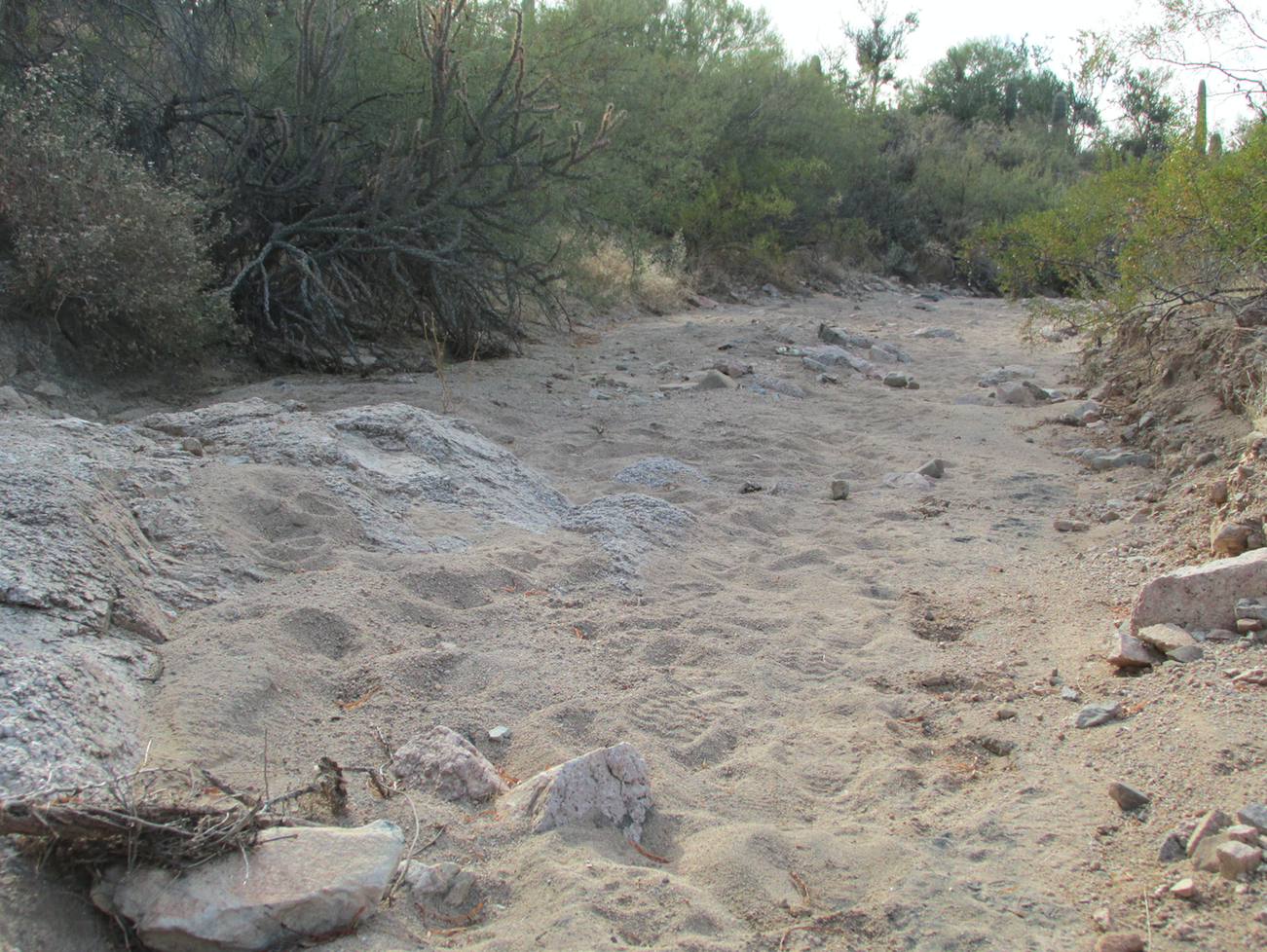 as a massive sluice box. Many of the principles you’re used to when prospecting and mining in waterways, will translate into desert mining. The most important thing to remember is that water is crucial to gold movement. Unlike a running river or creek with highs and lows, desert placers are much different in that gold is moved quickly during a flash flood, leaving gold stranded as opposed to being moved further by continual water flow in a creek.
as a massive sluice box. Many of the principles you’re used to when prospecting and mining in waterways, will translate into desert mining. The most important thing to remember is that water is crucial to gold movement. Unlike a running river or creek with highs and lows, desert placers are much different in that gold is moved quickly during a flash flood, leaving gold stranded as opposed to being moved further by continual water flow in a creek.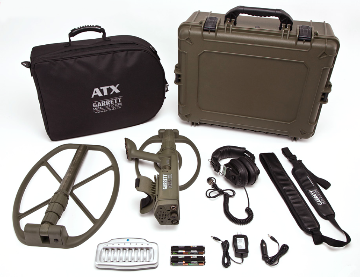
 my wrist, which gave it a perfect fit and feel, and allowed me to work all of the control buttons easily with my thumb. I pushed the unit out in front of me a bit and turned on the power switch, which is located on the back of the unit. The Garrett ATX Deepseeker Metal Detector goes through its startup and self-diagnostic test. Every light on the control pad comes on and unit emits several different sounds before settling into a comfortable, but high, threshold. This is not a turn-on-and-go detector. Either read the entire owners manual before you go out hunting, or at least read the first two pages of the manual— page 1 is the Quick Start Guide and an explanation of how to access the functions of the ATX quickly, and page 2 shows you where to find more information concerning those functions.
my wrist, which gave it a perfect fit and feel, and allowed me to work all of the control buttons easily with my thumb. I pushed the unit out in front of me a bit and turned on the power switch, which is located on the back of the unit. The Garrett ATX Deepseeker Metal Detector goes through its startup and self-diagnostic test. Every light on the control pad comes on and unit emits several different sounds before settling into a comfortable, but high, threshold. This is not a turn-on-and-go detector. Either read the entire owners manual before you go out hunting, or at least read the first two pages of the manual— page 1 is the Quick Start Guide and an explanation of how to access the functions of the ATX quickly, and page 2 shows you where to find more information concerning those functions.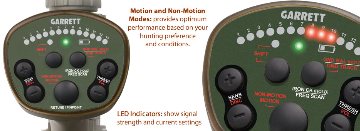 There are 5 major functions that are completely user-adjustable: Mode, Sensitivity, Threshold, Volume, and Ground Balance. Are functions are easy to adjust with a basic understanding of the ATX and more tunable as you become more proficient. Secondary functions include iron check, tracking, discrimmination and frequency shifting, to name only a few.
There are 5 major functions that are completely user-adjustable: Mode, Sensitivity, Threshold, Volume, and Ground Balance. Are functions are easy to adjust with a basic understanding of the ATX and more tunable as you become more proficient. Secondary functions include iron check, tracking, discrimmination and frequency shifting, to name only a few.